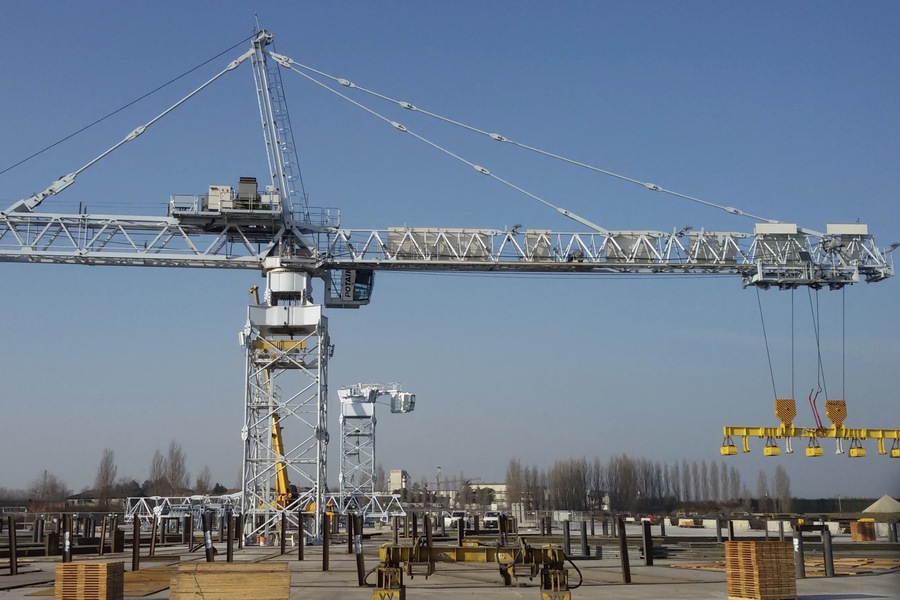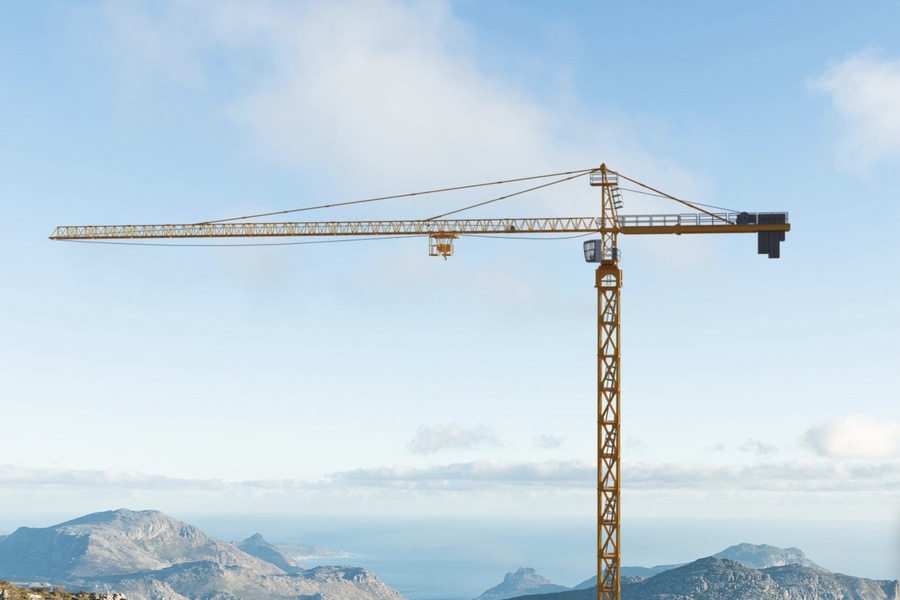Cranes with a fixed tower are a specialized type of tower crane where the platform and tower remain stationary during operation. These cranes are distinct because their slewing mechanism is located at the top of the tower, which rotates while the tower itself remains in a fixed position. This design incorporates a rotating head equipped with a counterweight console, which balances the boom as it lifts and moves heavy loads. A reputable crane company in UAE may offer these cranes for projects requiring high lifting capacity. Despite their reduced maneuverability compared to other types of cranes, cranes with a fixed tower offer a significantly higher lifting capacity, making them ideal for projects that require lifting heavy loads to considerable heights—up to 220 meters.
Key Design Elements of Fixed Tower Cranes
The structural design of fixed tower cranes includes several essential components, each contributing to the crane’s performance and stability. Understanding these elements is crucial for selecting the right crane for specific construction or industrial needs.
1. Tower
The tower is a robust metal structure that is rigidly fixed in a vertical position, either on a support base or a rotating platform. It serves as the central axis of the crane and supports the boom and other components. In cranes with a fixed tower, the tower does not rotate, contributing to greater stability during heavy lifting operations.
2. Undercarriage
The undercarriage is responsible for transferring loads to the crane’s tracks, ensuring that the crane remains stable and secure. For non-rotating tower cranes, the undercarriage typically consists of a frame shaped like a truncated pyramid or tent, providing a stable foundation for the crane during operation.
3. Boom
The boom is the horizontal arm that extends from the tower and is responsible for reaching and moving loads located at a distance from the crane. It plays a critical role in determining the crane’s reach and load-bearing capacity.
4. Counterweights
Counterweights are strategically placed at the end of the counterweight console, which is attached to the rotating head. These counterweights help stabilize the crane during lifting operations by balancing the boom’s weight and preventing the crane from tipping over.
5. Winches
Winches are essential for the crane’s lifting operations. They are located on the opposite side of the boom and consist of several components, including an electric motor, drum, brake, and gearbox. These mechanisms work together to lift and lower loads with precision.
6. Operator’s Cabin
The operator’s cabin is usually located at the top of the tower, providing the crane operator with an unobstructed view of the work area. This high vantage point allows the operator to efficiently control the crane’s movements and ensure safe and accurate lifting operations.

Operating Principles of Fixed Tower Cranes
The operation of fixed tower cranes is a coordinated process involving several key movements:
– Lifting Loads: The crane lifts heavy loads using a cargo winch, cargo rope, and hook block. The winch controls the upward and downward movement of the load, while the cargo rope and hook block secure the load in place.
– Changing Boom Reach: Depending on the crane’s design, the boom’s reach can be adjusted by either raising or lowering the boom itself or by moving the cargo trolley along the boom. This flexibility allows the crane to position loads at varying distances from the tower.
– Rotation of the Crane’s Rotating Part: The crane’s rotating head, located at the top of the tower, rotates independently of the non-rotating tower. This rotation is enabled by a slewing bearing device, which transfers vertical and tipping loads from the rotating head to the stationary tower. This movement allows the crane to service a wide area, making it ideal for construction and industrial applications.
Applications of Fixed Tower Cranes
Fixed tower cranes are versatile machines with various applications across different industries. Their ability to lift heavy loads to significant heights makes them suitable for a range of tasks:
- Construction: These cranes are often used in construction projects, especially in urban environments where space is limited. Due to their high lifting capacity and stability, fixed tower cranes are ideal for projects that require lifting heavy materials to great heights, such as high-rise buildings and skyscrapers.
- Industrial Enterprises: Fixed tower cranes are also used in industrial settings, where they move large, heavy structures and components. They are commonly employed in loading and unloading operations, as well as in the transportation of goods within warehouse complexes.
- Specialized Tasks: In certain niche industries, fixed tower cranes solve unique lifting challenges. Their design makes them suitable for highly specialized tasks where stability and height are more critical than maneuverability.
Advantages of Fixed Tower Cranes
Fixed tower cranes offer several significant advantages that make them a preferred choice for specific construction and industrial projects:
- Superior Visibility: The operator’s cabin, positioned at the top of the tower, provides excellent visibility over the worksite. This panoramic view allows the operator to monitor and control crane operations with precision, enhancing safety and efficiency.
- High Altitude Boom: The boom of a fixed tower crane is located at a significant height, ensuring that it does not interfere with the structures under construction. This makes these cranes ideal for working in confined spaces or densely built areas.
- Simplicity and Reliability: The design of fixed tower cranes is straightforward and robust, making them easy to operate and maintain. Their simplicity contributes to long-term reliability, especially in demanding environments.
- Large Working Area: Fixed tower cranes offer a large linear working area, enabling them to cover a significant portion of the construction site without needing to move.
Disadvantages of Fixed Tower Cranes
While fixed tower cranes have many benefits, they also have some disadvantages that need to be considered:
- High Metal Consumption: The tower of a fixed crane needs to be reinforced to handle the increased load and prevent swaying during operations. This leads to higher material costs and increased weight, making the crane more difficult to transport and install.
- Need for Mobile Cranes During Installation: Fixed tower cranes require mobile cranes for assembly and disassembly, adding to the overall cost and complexity of the project.
- Limited Access to Crane Drives: Maintenance and inspection of the crane’s mechanisms, particularly the drives, can be challenging since they are only accessible through the roof of the cabin.
- Dismantling Cabins for Transport: When moving the crane from one site to another, the operator’s cabin must often be dismantled to facilitate transport, further increasing downtime and labor costs.

Leading Manufacturers of Fixed Tower Cranes
Several companies specialize in the manufacture of fixed tower cranes, providing a range of models to suit different construction and industrial needs. Leading manufacturers include:
– IHI
– Jaso
– Linden-Comansa
– Ogawa
– PPM
– Raimondi
– Zeppelin (ZBS series)
These companies offer advanced crane models that incorporate cutting-edge technology and engineering, ensuring reliability, safety, and efficiency in heavy lifting operations.
Conclusion
Cranes with a fixed tower are a highly specialized type of tower crane, designed to lift heavy loads to great heights with stability and precision. While they lack the maneuverability of other crane types, their high lifting capacity, simple design, and reliability make them a preferred choice for urban construction projects, industrial operations, and specialized tasks. Understanding the advantages and disadvantages of fixed tower cranes, as well as their applications and design elements, is essential for making informed decisions in construction and industrial planning. The right choice of a crane can improve efficiency, enhance safety, and reduce project costs.
I am a dedicated entrepreneur and tech enthusiast from Silicon Valley. After earning a degree in computer science from Stanford, I co-founded several startups seeking to disrupt industries with innovative technologies. Besides business, I love to travel and mentor aspiring entrepreneurs, driven by a vision for a better future.
